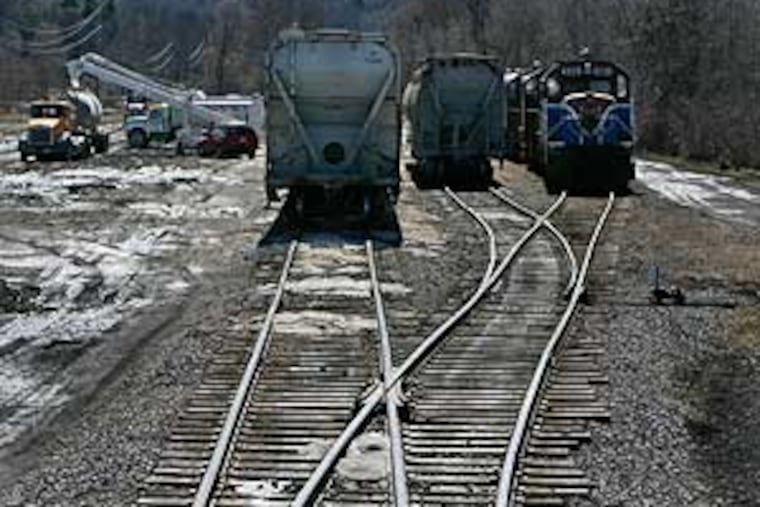Between the rocks
For better fracking, researchers at Penn State have developed a ceramic substitute for sand. It’s made of mine waste.

Amid all the fuss over the water and chemicals consumed in hydraulic fracturing, few people pay attention to the other ingredient used in fracking a gas well: sand.
But John R. Hellmann does.
Long before the Marcellus Shale natural gas boom hit Pennsylvania, Hellmann and Barry Scheetz, Pennsylvania State University engineering professors, were consumed with researching "proppants" - the stuff pumped into oil and gas wells to prop open the tiny cracks created during fracking. The most common proppant is sand.
The Penn State researchers have developed a synthetic proppant they call PennProp that they say will work better than sand. The ceramic proppant looks like poppy seeds.
PennProp is made in Pennsylvania from mine waste, so Hellmann says it would recycle rock cuttings that now go to landfills. "The environmental advantages are pretty high on our list," he said. "We like that whole idea."
Such is the nationwide frenzy to drill for oil and natural gas in unconventional rock formations like shale that demand for proppant has gone bonkers. A typical Marcellus well now consumes 5 million pounds of sand, enough to fill 25 railcars. It all comes from Midwestern sand mines.
Marcellus drilling accounts for about 14 percent of the nation's 79 billion-pound proppant market this year, according to the investment bank Global Hunter Securities L.L.C. That would fill a train stretching from Maine to California.
"The market for this stuff is enormous," Hellmann said. The Freedonia Group Inc., a research firm, estimates the proppant demand is increasing 15 percent a year, and will reach $3.2 billion in 2014.
Ben Franklin Technology Partners of Central and Northern Pennsylvania, a state-funded agency that assists start-ups, saw promise in PennProp, invested $167,000 this year, and helped the researchers form a company, Nittany Extraction Technlogies L.L.C.
Ben Franklin also recruited an entrepreneur, Marty Bradley, to run the company. Bradley said his goal was to attract about $15 million in private capital to produce hundreds of tons of proppant to test in an actual well. He started out by matching Ben Franklin's investment.
"I've been investing in Penn State start-ups since 1994," said Bradley, "and I'm happily putting my own money into this effort - the risk-reward is there."
The investment is the first for Ben Franklin's new Shale Gas Innovation and Commercialization Center, which is aimed at incubating businesses related to the natural gas industry. The idea, said Ben Franklin's president, Stephen Brawley, is "maximizing the bang for buck" from the Marcellus boom.
Proppant might seem mundane, but it is the key ingredient in hydraulic fracturing, which has opened up vast oil and gas reserves for exploitation.
Hydraulic fracturing involves the high-pressure injection of water, chemicals, and proppant into a well to shatter impermeable rock. The fractures create pathways for oil and natural gas to escape into the well bore and flow to the surface.
Though the industry maintains fracking is harmless, it has been vilified by anti-drilling activists. The U.S. Environmental Protection Agency is conducting a two-year study on its environmental and health consequences.
Since the first well was hydraulically fractured in 1949, engineers have experimented with many different proppants, including broken walnut shells. Cheap and plentiful sand became the preferred proppant and now accounts for 88 percent of the market, according to research by industry consultants PropTester Inc. and Kelrik L.L.C.
Not all sand is suitable for proppant. Sand quarried from large Midwestern deposits has spherically shaped granules that flow smoothly into wells and leave sufficient gaps between the grains to allow oil and gas to flow.
But sand has limitations. In deeper wells, it is crushed under the tremendous weight of the earth, clogging the fractures and reducing production. Some producers strengthen the sand by coating it with resin.
A superior alternative is ceramic proppant, whose uniform shape and high strength boost gas production. Ceramics are produced from bauxite or kaolin clay, and they cost at least three times more than sand.
Nevertheless, ceramic producers cannot keep up with demand. Even Chinese imports cannot fill the market need.
Carbo Ceramics Inc., of Houston, the leading U.S. supplier, added two new plants this year. Its proppants sold for 35.1 cents per pound in the first quarter, up 12 percent over last year. Its stock price has doubled.
"The market is not being served by the manufacturing capacity that's out there, so there's room for another," said Nittany's Hellmann, a professor of materials science.
Rather than using expensive raw materials, PennProp is engineered to use waste from metabasalt mines. Heated to 3,000 degrees, the metabasalt forms into molten obsidian spheres. The glassy pellets are then heat-tempered into a hardened ceramic.
"I think we have a technology that's timely, that's indigenous to Pennsylvania, that can go a long way to reviving our refractories industry," Hellmann said. "It's simply enormous."
It also requires a lot of energy, potentially creating a new customer for the natural gas industry.